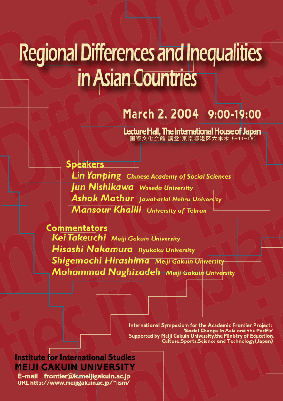
International Conference for the Academic Frontier Project:
eSocial
Change in Asia and the Pacificf
Supported by
Meiji Gakuin
University,
the Ministry of Education, Culture, Sports, Science and
Technology (Japan)
and
Institute for International Studies
Meiji Gakuin University

March 2, 2004
9:00-19:00
Lecture Hall, The International House of Japan
iÛ¶»ïÙ@u°j
Agenda
1. Viewpoint @@@World wide economic inequality, the so-called South-North problem, is the most important issue in the world of the 21 st century. However, the inequalities and differences not only exist between countries, but also within countries, especially in developing nations, where a few, or sometimes many, rich people enjoy a very comfortable life, equal to or better than the life of the people of rich nations, while the majority of people cannot even the afford basic necessities of life. @@@These intra-country inequalities often appear as differences between regions within a country. In many developing nations, quickly expanding metropolitan cities are nearly the same as Western cities in appearance and in facilities for modern life, where upper middle class people can enjoy nearly the same modern lifestyle as their colleagues in rich advanced nations. However, in most rural areas, and in the gslumh areas of cities where there is always great unemployment, most people are poor, often hungry, and most of the modern facilities of life and social infrastructure are totally lacking or very short of demand. @@@South-North differences are now reflected in intra-country regional differences in developing nations, and the latter can be considered to be the most important factor of the former. @@@From this viewpoint, we propose to study regional differences and inequalities within developing nations, especially in Asian countries. 2. Method @@@Among various social inequalities and differences, regional differences are, usually, most easily obtained from statistical figures, which is another reason why we propose to consider regional differences as representative of social differences within a country. @@@There are figures available provided by statistical agencies in respective countries, and although their quality and quantity vary greatly from country to country, at least in some countries there exist now a great amount of regional statistics. For example, in China every province now publishes a thick volume of statistics yearly which provides provincial sub-regional figures. @@@The first step of the analysis of regional differences is to compare per capita averages of gross product, net income, private consumption, etc, in each region, which is the regional breakdown of the national accounting. This can produce the simplest measure of regional economic inequalities, though we have to be cautious about the reliability of figures. @@@We have also to consider the structure of each regional economy, such as the composition of industries in terms of employment and production, and sub-regional differences within the region. @@@Factors other than economic are also important, especially mortality, birth rate, and degree of education, among others. @@@We also have to consider differences in stock other than gflowh represented by GDP, such as size of land, natural resources, and social facilities. @@@Sometimes intra-region sub-regional differences are also important, and can be measured from small area statistics. @@@Regional differences are always intermixed with various social factors of differentiation, such as industrial sectors, social class, gender and sometimes religion and race. We cannot conceive of a gpure effect of regional differenceh but we regard the regional differences as the comprehensive measure of social differences in a country. @@@Our objection is not restricted merely to the study and disclosure of vast inequalities in Asian countries, but also includes the pursuit of measures to improve the situation, hence the inclusion of political dimensions in our study. |
Speakers
| Lin Yanping | Chinese Academy of Social Sciences |
| Jun Nishikawa | Waseda University |
| Ashok Mathur | Jawaharlal Nehru University |
| Mansour Khalili | University of Tehran |
Commentators
| Kei Takeuchi | Meiji Gakuin University |
| Hisashi Nakamura | Ryukoku University |
| Shigemochi Hirashima | Meiji Gakuin University |
| Mohammad Naghizadeh | Meiji Gakuin University |
Chairs
| Junji Shiba | Meiji Gakuin University |
| Makoto Katsumata | Meiji Gakuin University |
Program: March 2 (Tue.)
| 9:00-9:45@OPENING REMARKS and KEYNOTE SPEECH |
| Kei Takeuchi |
| 9:45-11:15@SESSION 1@gRegional Differences and Inequalities in Chinah |
| Chair: | Junji Shiba |
| Speaker: | Lin Yanping |
| @gRegional Differences and Inequalities of Educatinal Opportunities @@@ in Chinah |
|
| Commentator: | Kei Takeuchi |
(RECESS)
| 11:30-13:00@SESSION 2@gRegional Differences and Inequalities in Southeast Asiah |
| Chair: | Makoto Katsumata |
| Speaker: | Jun Nishikawa |
| @gHow to Overcome Regional Differences and Inequalities?: @@@ Perspective of the Endogenous Development Theoryh |
|
| Commentator: | Hisashi Nakamura |
(LUNCH)
| 14:00-15:30@SESSION 3@gRegional Differences and Inequalities in Indiah |
| Chair: | Mansour Khalili |
| Speaker: | Ashok Mathur |
| @gRegional Income Disparities and Their Interface with Social @@@ Well-Being in Indiah |
|
| Commentator: | Shigemochi Hirashima |
(RECESS)
| 15:45-17:15@SESSION 4@gRegional Differences and Inequalities in Iranh |
| Chair: | Ashok Mathur |
| Speaker: | Mansour Khalili |
| @gRegional Inequalities in Iran: Diverging or Converging?h | |
| Commentator: | Mohammad Naghizadeh |
| 17:30-18:30@PANEL DISCUSSION |
| Chair: | Shigemochi Hirashima |
| 18:30-18:45@CLOSING REMARKS |
| Shigemochi Hirashima |
| 19:00-@@@@Reception@(at Reception Hall 1) |
![]() wpteBAÌgbvy[WÖßé
wpteBAÌgbvy[WÖßé
![]() Ûwt®¤Ìgbvy[WÖßé
Ûwt®¤Ìgbvy[WÖßé